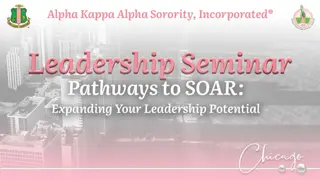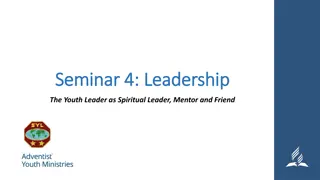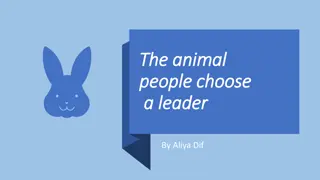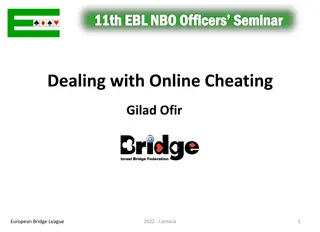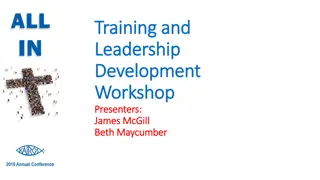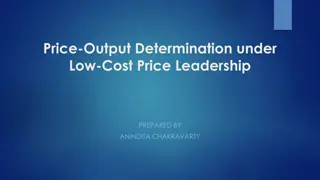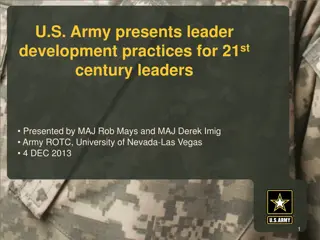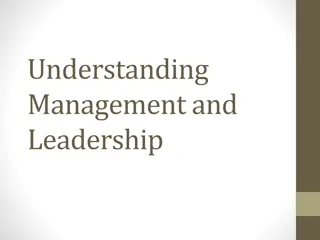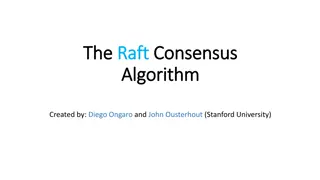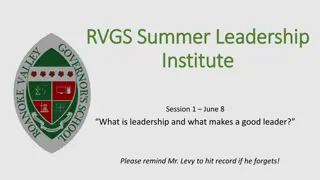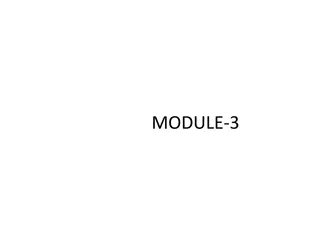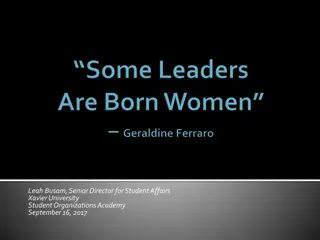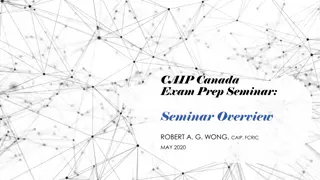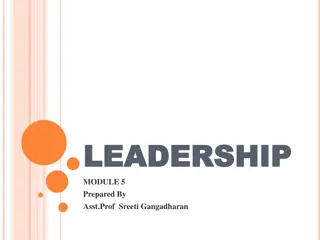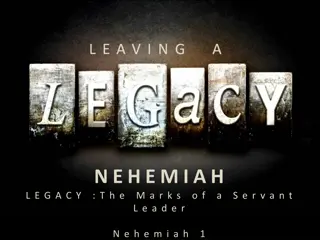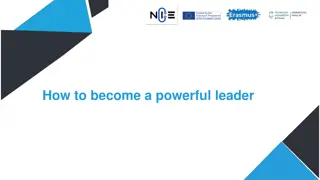AOH Leadership Seminar - Be the Kind of Leader You Would Follow
Today's AOH Leadership Seminar aims to help participants learn qualities of effective leadership, understand leadership levels, develop future leaders, ensure continuity of operations, review the AOH Blue Book, and handle proper forms and paperwork. The seminar covers modules on AOH leadership, fostering future leaders, continuity, Blue Book 101, paperwork and forms, and review. Presenters will engage participants in activities like an icebreaker and a review of essential handouts. The seminar emphasizes the importance of establishing a clear vision, sharing it with others, providing necessary resources, balancing interests, and inspiring others to achieve common goals.
Download Presentation

Please find below an Image/Link to download the presentation.
The content on the website is provided AS IS for your information and personal use only. It may not be sold, licensed, or shared on other websites without obtaining consent from the author. Download presentation by click this link. If you encounter any issues during the download, it is possible that the publisher has removed the file from their server.
E N D
Presentation Transcript
AOH LEADERSHIP SEMINAR Be the Kind of leader you would follow 1
Seminar Objectives Today, we hope to: Learn qualities of effective leadership Better understand AOH leadership levels Ways to develop future leadership Ensure continuity of leadership and operations Review AOH Bluebook Understand proper forms and paperwork 3
Modules I. AOH Leadership II. Fostering Future Leaders III. Continuity IV. Blue Book 101 V. Paperwork and Forms VI. Review and Roundtable 4
AOH LEADERSHIP SEMINAR TODAY S PRESENTERS- 5
ICEBREAKER -Name -Division -How long involved -Title 1 Trait a Leader Must Process Where is the AOH in 10 Years? 6
REVIEW OF HANDOUTS *AOH Manual- THE BLUEBOOK *AOH NATIONAL CONSTITUTION (7/15) *STATE By-Laws (Provided by State) *AOH Form 9 *AOH Form 11 *AOH Form 12 7
Module ONE 8
AOH LEADERSHIP Leadership- THE ACTION OF LEADING A GROUP OF PEOPLE OR AN ORGANIZATION 9
Leadership Involves: 1. Establishing a clear vision 2. Sharing that vision with others so that they will follow willingly 3. Providing the information, knowledge and methods to realize that vision 4. Coordinating and balancing the interests of all members 5.Inspiring others to perform and engage in achieving a goal 10
OUR LEADERSHIP NATIONAL STATE COUNTY DIVISION JUNIOR 13
ELECTED NATIONAL OFFICERS Article VIII Section 2 President-James McKay Vice President-Danny O Connell Art X Sec. 2 Secretary-Jere Cole Treasurer-Sean Pender Directors (6) Dan Dennehy Liam McNabb Denny Parks Art X Sec. 1 Tom O Donnell Bill Sullivan John Wilson Art X Sec.3 Art X Sec.6 Art X Sec. 14 14
ELECTED STATE OFFICERS Article VIII Sec. 3 (As prescribed by State By-Laws) President Vice President Secretary Treasurer Directors Art. X Sec 2 Art. X Sec.3 Art. X Sec 6 Art. X Sec.1 15
ELECTED COUNTY OFFICERS Article VIII Sec. 5 (Where 2 or Divisions exist within the County) President Vice President Recording Secretary Financial Secretary Treasurer Marshal Sentinel Chairman of Standing Committee Bluebook Pg 27 Art. X Sec.1 Art. X Sec 2 Art. X Sec 4, Art. X Sec 5 Art. X Sec. 6 Bluebook Pg 27 Bluebook Pg 27 16
ELECTED DIVISION OFFICERS Article VIII Sec.7 President Vice President Recording Secretary Financial Secretary Treasurer Marshal Sentinel Chairman of Standing Committee 17
APPOINTED OFFICERS Chaplain Historian/Archivist Organizer FFAI Charities and Missions Catholic Action Pro-Life Political Education Com Veterans Affairs Immigration Art X Sec 7,8 Art X Sec 9,10 Art X Sec 12,13 Art X Sec. 15 Art X Sec 16,17 Art X Sec 18 Art X Sec 20 Art X Sec 21 Art X Sec 22 Art X Sec 23 18
OTHER APPOINTED OFFICERS Newsletter Editor Legal Counsel Sports Project St. Patrick Hunger Fundraising Directors Finance/Trustees Rituals 19
LeadershipInvesting in the Order Leadership is important on every level (National State, County & Division) for the health and well being of the Order. Critical functions of Leaders is to: Engage others (Officers and Members) Identify goals for the term (what are desired outcomes?) Develop a work plan Coach and Mentor Set an Example for others Plant seeds for the future 20
Engage OthersBuild Your Team Involve others to discuss operations for today and the future: What do they think is important for the organization? (Buy-In is critical ) What can they do to help? (any skills, talents, etc.?) Who else can join the mission? 21
Knowledge is Power Setting the Stage Know your job!!! (Respect lines of authority, etc.) What are the duties and expectations of each Officer (Blue Book)? Leaders need to be a resource or Go To for others to learn more about the Order, Officer s duties, procedures, etc. Who is playing what role as it relates to operations, initiatives, etc.? Talk openly about the duties of Officers as it will help others better understand operations of the Order. 22
Identify Goals for Term What are your priorities? What is important to others? Timeframes? Measuring success (how will you know you achieved your goals?) Ownershipis critical for Buy In Talk openly about goals (distinguish short term and long term goals) Who else can serve as key leaders? 23
Develop a Work Plan What are the steps to achieving the group s goals? Division, County, State Level Operations: Who are the key leaders? What is everyone s role? Are they fully aware of their role? Initiatives, Special Projects: Who are the key leaders? What is everyone s role? What resources are needed? (funding, committees, partnering with LAOH, other community organizations, etc.) Do you have a theme? Liam s example: Give a Member a reason to be here, give him a reason to stay. 24
Coach and Mentor Follow up with everyone: Need to check in and show support, encouragement. What is working well and what isn t? What can you do to help? Are more or different resources needed? Promote and celebrate successes. 25
Mentoring Starts at Recruitment Mentor is also a advocate Ongoing Formalizing a program within Division Building the Farm team 27
Serve as an Example for others Always be professional (members and officers are always watching you) Be positive and solution focused Highlight strengths of others Don t assign a duty you haven t performed yourself If you represent the Order with integrity, others will follow 28
Review: Top 10 Qualities that make a Leader Honesty Delegate Communication Confidence Commitment Positive Attitude Creativity Intuition Inspire Approach The most powerful leadership tool you have is your own personal example John Wooden 29
Module TWO 30
Assign Tasks Start Simple if needed Committee Assignment Use Skills/Specialty Age Appropriate Teamwork 34
Millennials 35
Millennial -A Millennial is the name given to the generation born between 1982 and 2004. The Millennial generation follows Generation X (1961-1981) in order of demographic cohorts. This Generation is often associated with technology and social media. Also known as Generation Y CURRENTLY THE 2nd LARGEST GENRATION IN THE UNITED STATES 36
Millennial -Millennial have come to age during a time of technological change, globalization and economic disruption . That s given them a different set of behaviors and experiences than their parents -Are often considered young, smart and brash -While they want to work, they do not want their work to be their entire life -They have been have been nurtured and programmed with a slew of activities since they were toddlers, meaning they are both high performers and high maintence -They are considered multitaskers 37
Module THREE 39
Continuity 40
What is Continuity? The Unbroken and Consistent existence or operation of something over a period of time. 41
Continuity=Survival Plan for the Future Invest in the Order 42
1. Adapt to Change -Changes in: -Society -Culture -People -The Organization 43
2.Embrace Technology -Social Media -Webinars -Communications -Emerging Tech 44
3. Run it like a Business -Budgeting -Team Building -Overall Vision -Yearly Review 45
4.Fix what needs it -Term Limits -1 year vs. 2 year -Group Solutions -Avoid age old mistakes 46
5. Plan for the Future Develop 5 year and 10 year plans Encourage advancement of Officers- moving up the Chairs Develop officers (members shadowing current Officers) Fundraising and setting budget goals Long Term Goals (What can we do now to ensure the Order is healthy in 10 years?) 47
6. Hand off the Torch Prepare others for new roles. Know when it s time to step back. Challenge others by challenging yourself: A member without a track record doesn t mean he can t do a job Have faith in others to continue to mission Conflict or inactivity may lead to a takeover Keep focus on the Good of the Order 48
MODULE Four 49


